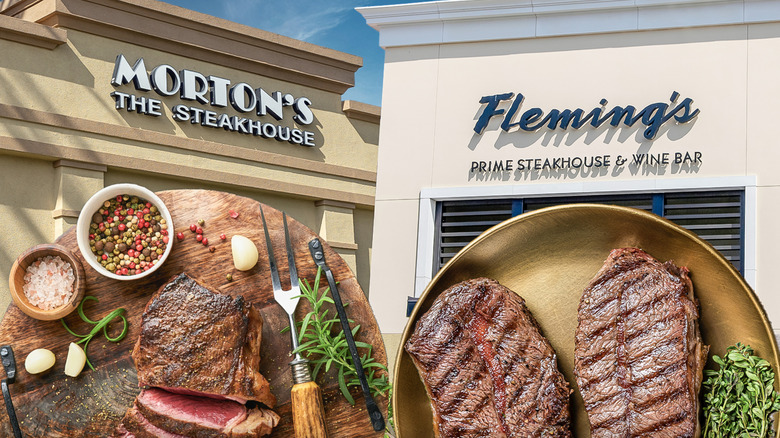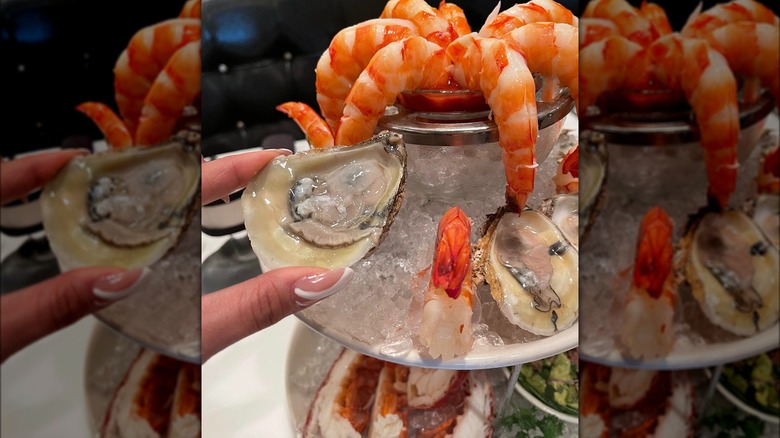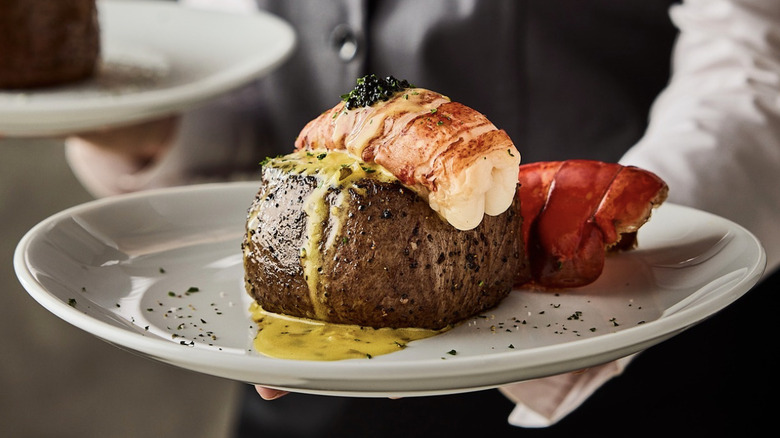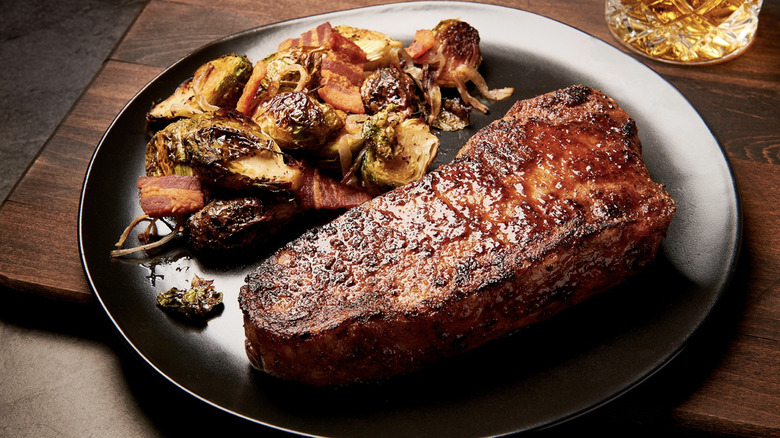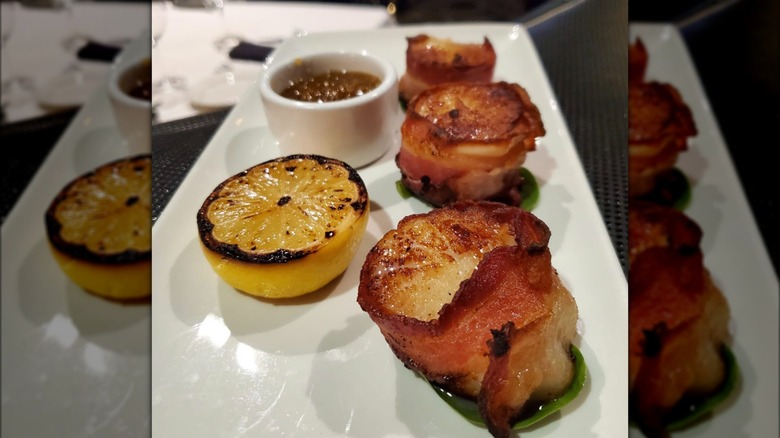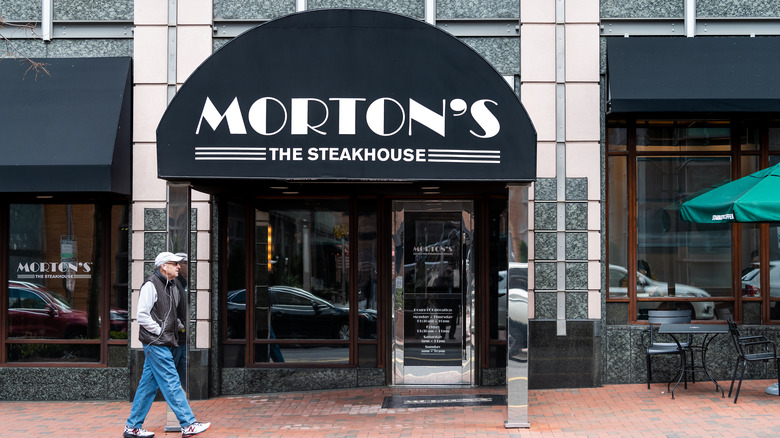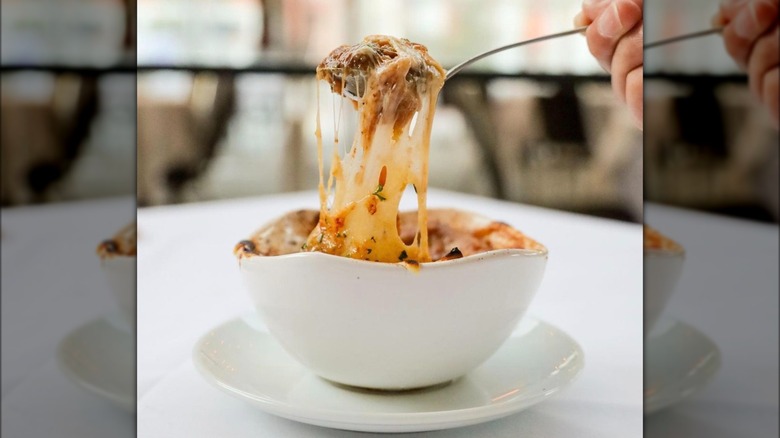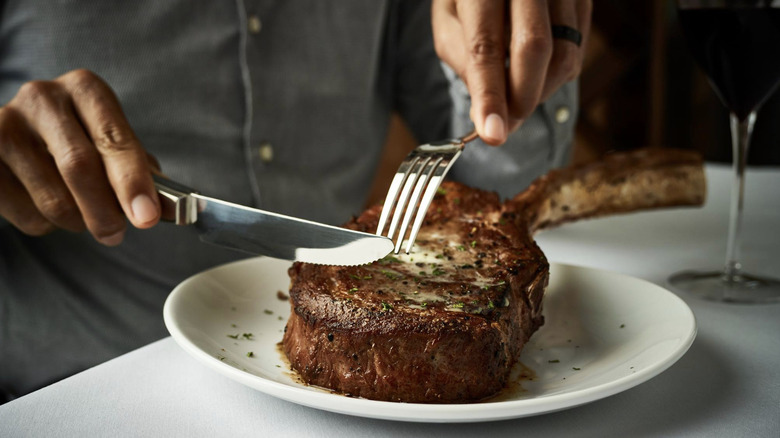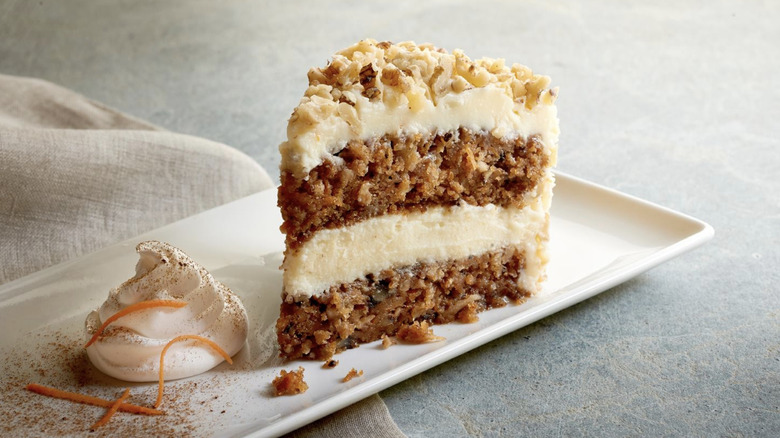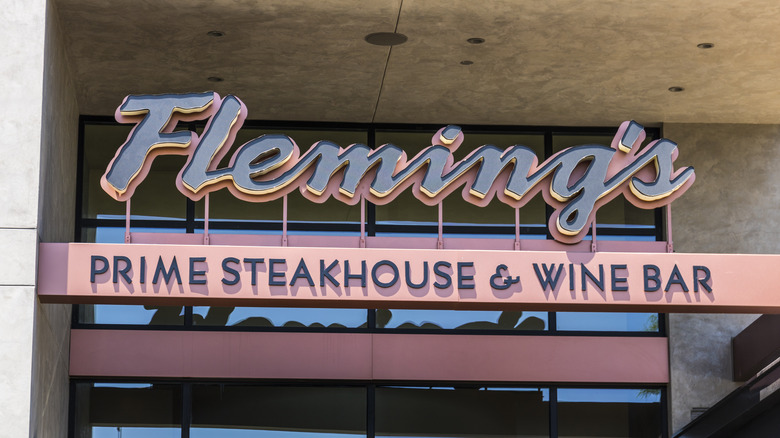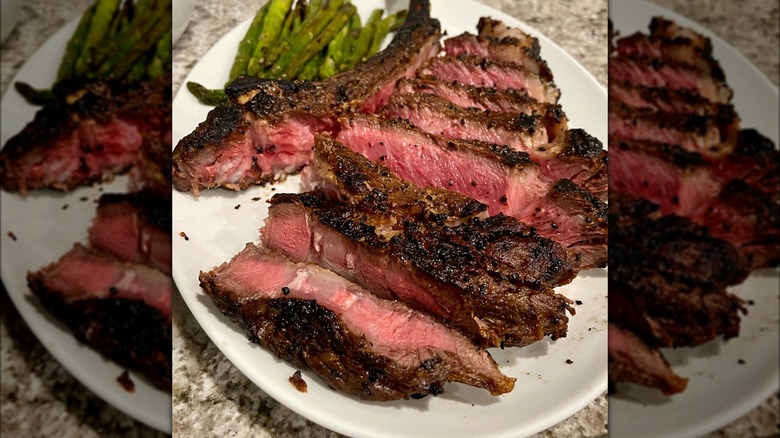Fleming's Vs Morton's: Which Is Better?
Steakhouse chains each offer a unique dining experience. Some restaurants cater to casual get-togethers and family dinners with a relaxed atmosphere and wallet-friendly prices. Others are more upscale, focusing on providing a refined dining experience with high-quality steaks and an extensive list of wine pairings. Both Fleming's and Morton's fall into the latter category.
There's no denying the fact that Fleming's and Morton's are rather similar in their ambiance, menu offerings, and services, a similarity that makes them popular choices for sophisticated dining and business gatherings. This being said, the two chains aren't identical. While our assessment focused on some of the similarities between the two establishments, we also searched for the elements that make them unique in terms of decor, as well as food quality and preparation. If you would like to find out more about our evaluation process, take a look at the methodology at the end of this article.
Both chains have updated their design concepts
The steakhouse world is changing. Classic steakhouses, known for their dark interiors, plush seating, and a masculine ambiance reminiscent of a bygone era, are no longer the benchmark. Instead, chains like Fleming's and Morton's are leading the way in modernizing the steakhouse experience, starting with the decor.
While each Fleming's location is unique, the chain has been updating its restaurants to fit with its new, more contemporary design aesthetic. Some of the common elements of this revamp include brighter colors, larger windows, open kitchens, and private dining areas. For instance, Fleming's in the L.A. Live development in Los Angeles features translucent onyx panels, stylish lighting, and a glass wine vault. Meanwhile, the chain's new location in Tampa boasts a porte-cochere, 16-foot glass walls, vaulted ceilings, and neutral, earth-toned touches.
Morton's has also made a conscious effort to move away from the traditional, heavy aesthetic typically associated with many steakhouses. A multitude of the chain's locations have been updated with fresh carpeting and upholstery, as well as a more open layout, with the previously shuttered windows now remodeled to let in light. Some of the other elements found in the revamped restaurants include leather booths, chrome finishes, and art deco touches.
Morton's has a Raw Bar while Fleming's offers a Chilled Shellfish Tower
Both Fleming's and Morton's serve high-quality seafood, some of it chilled. The Raw Bar at Morton's offers a plethora of marine delicacies including oysters on the half shell, ahi tuna poke, and three types of seafood cocktails — lobster, crab, and jumbo shrimp. For indecisive seafood enthusiasts, Morton's offers the Ocean Platter with oysters, ahi tuna poke, jumbo shrimp cocktail, and the star of the show — cold-water lobster tail. The starter comes in a manageable grand size and an impressive epic size, which is perfect for sharing.
While Fleming's doesn't feature a special Raw Bar section in its menu, the chain's chilled seafood offerings definitely hold their own. The restaurant serves a colossal shrimp cocktail with horseradish sauce, fresh oysters with house-made mignonette, and an ahi tuna poke stack with caviar. To round things out, Fleming's also offers a decadent Chilled Shellfish Tower featuring North Atlantic lobster, Alaskan golden king crab legs, colossal shrimp, and fresh oysters.
Those looking for a warm seafood starter, may wish to try Morton's Bacon Wrapped Sea Scallops, Jumbo Lump Crab Cake, or Shrimp Calabria prepared Mediterranean style. For entrees, the chain offers aquatic specialties such as one pound of King Crab Legs, Maine Lobster Ravioli, and Miso Marinated Sea Bass. Fleming's also features apps such as Crab Cakes and Sweet Chili Calamari, as well as mains including Seared Scallops, Barbecue Salmon Fillet, and Miso-Glazed Chilean Bass.
Both chains serve various cuts of USDA Prime beef and other types of beef
Both Fleming's and Morton's serve USDA Prime cuts, the highest grade of USDA beef available. Boasting abundant marbling, USDA Prime beef trumps both USDA Choice and USDA Select cuts in terms of flavor and texture. USDA Prime steak accounts for only the top 2% of all beef graded by the organization. The cuts at Fleming's come from small Midwest farms, which feed their cattle a grain-based diet for at least 200 days to ensure that the meat is richly marbled. In addition, Morton's claims that it has used the same beef supplies since the restaurant first opened its doors.
As steakhouses, both chains serve a variety of steaks prepared to each diner's exact specifications. The USDA Prime cuts at Fleming's include bone-in ribeye, tomahawk, and New York strip. Meanwhile, the chain's classic ribeye cut is made using Certified Angus Beef. Fleming's also offers classic cuts such as filet mignon, bone-in filet mignon, and petite filet mignon, which make up some of its leanest and most tender steak offerings. Last but definitely not least, Fleming's also offers Japanese A5 Wagyu served on a sizzling hot stone plate at select locations.
The range of USDA Prime steak cuts served at Morton's includes filet mignon, ribeye, bone-in ribeye, and New York strip. The chain also offers Wagyu filets, as well as Westholme Wagyu ribeye sourced from Westholme cattle from Australia.
Both restaurants age their steaks but use different preparation methods
According to Fleming's, "Every single second and chef decision impacts the final flavor and experience" of enjoying a quality steak. Leaving nothing to chance, Fleming's is precise about the way it prepares its steak. Most of the chain's beef is wet aged for at least 21 days to ensure that it's both tender and flavorful, with only the bone-in ribeye dry aged for up to 30 days to imbue the cut with a stronger, nuttier flavor. After sprinkling the steaks with kosher salt and freshly cracked pepper, the chain charbroils them at exactly 1,600 F. The steaks are served on 350 F plates with a dollop of butter and a little parsley.
Morton's beef is aged for between 23 and 28 days, although the chain doesn't specify whether it wet or dry ages its meat. While we can't be sure how Morton's prepares its steaks, the chain does offer its customers several tips for preparing beef at home. According to the chain, the cut should be between an inch and a half and two inches thick, and the meat should be brought to room temperature before cooking. Finally, the beef should be grilled at between 425 to 450 F, and only flipped once it has a dark char finish on one side.
Morton's offers more ways to enhance its steak with sauces and pairings
While some say that steak is best enjoyed with nothing but a little salt, others prefer their beef with a side of sauce or even a seafood topping. Aware that taste preferences can vary, Morton's lets diners mix and match their steak sauces and pairings. The steakhouse offers a wide range of sauces from simple garlic butter to more sophisticated options like blue cheese butter and black truffle butter. Several of the other sauces on offer include béarnaise sauce, cognac sauce au poivre, and whipped horseradish. Diners can also pair their steak with portions of seafood, such as Truffled King Crab Oscar, Bacon Wrapped Sea Scallops, Jumbo Grilled Shrimp, and Cold-Water Lobster Tail.
While Fleming's also lets its guests select add-ons to their steaks, the restaurant's sauce and pairing options are much more limited. In fact, the chain only offers a handful of enhancement options on its menu, including Diablo Shrimp, Oscar-Style Jumbo Lump Crab Meat, and Truffle-Poached Lobster. For those not in the mood for seafood, Fleming's also offers Crispy Maitake Mushrooms.
The restaurants are similarly priced
Fleming's and Morton's both target affluent diners looking for quality dishes and an upscale dining environment. Since the chains aim at a similar demographic, it's only logical that their prices would also be similar. When it comes to appetizers and salads, both establishments offer several comparably priced options. While Morton's crab cakes cost $25, a similar dish at Fleming's will set diners back $28. Patrons can also expect to pay $15 for a wedge salad at Morton's and $17 for the same dish at Fleming's. The shellfish towers at both restaurants are also similarly priced, with the platter costing $85 and $160 at Morton's and $83 and $155 at Fleming's, depending on the size.
The steak cuts at both chains also come with similar price tags. For instance, a 22-ounce bone-in ribeye at Morton's costs $73 while a 20-ounce bone-in ribeye at Fleming's is priced at $68. Meanwhile, a 16-ounce New York strip at Morton's is $64 while exactly the same dish at Fleming's costs $63. Moving on, a 12-ounce filet mignon at Morton's is priced at $65 while a slightly smaller 11-ounce filet mignon cut at Fleming's is $59.
Fleming's and Morton's have a similar number of locations
Fleming's has significantly expanded its footprint since the restaurant first opened its doors to the public in Newport Beach, California, in 1998. Today, the chain boasts over 60 locations around the U.S., with the biggest presence in California, Florida, and Texas. Meanwhile the cities with the greatest number of Fleming's restaurants include Austin and Houston in Texas and Las Vegas in Nevada. Fleming's used to have an international location in São Paulo, Brazil, but the restaurant is now permanently closed.
Morton's has a slightly lower footprint in the U.S. than its competitor. Having first opened in Chicago, Illinois, in 1978, the chain expanded to more than 60 locations before contracting to around 55 restaurants. In fact, the establishment's very first restaurant on State Street in Chicago closed its doors during the pandemic. Today, Morton's boasts the greatest number of outlets in California and Florida, with 10 and seven locations respectively. In terms of cities, the steakhouse has the biggest foothold in New York and Houston. Morton's also has a number of international locations including in Hong Kong, China, Mexico, Canada, Singapore, Taiwan, and Japan.
The restaurants serve similar salads, soups, and side dishes
Fleming's and Morton's feature strikingly similar assortments of salads, soups, and sides. In fact, both steakhouses serve exactly the same soups – lobster bisque and French onion soup. The range of salads served at both chains is also very similar, with both establishments serving wedge salads, Caesar salads, and house salads. The only notable difference is that Morton's offers a Caprese Salad with Mediterranean flavors while Fleming's gives diners the option of ordering a Pickled Nectarine & Smoky Corn Salad with arugula, burrata, red onion, and agave lime vinaigrette.
In terms of side dishes, the offerings at both chains are also relatively similar, featuring several steakhouse favorites such as mashed potatoes, mac and cheese, grilled asparagus, and a loaded baked potato. Nevertheless, the chains do feature some variations in the side dish department that set them apart. For instance, Fleming's offers Sautéed Mushrooms, Creamed Spinach, and Pecorino Creamed Corn while Morton's serves Sautéed Spinach & Button Mushrooms, Truffled Cream Corn, and Thick Cut Onion Rings.
Both restaurants offer prix fixe menus
Many diners prefer the overall experience and value of set menus to à la carte menu options. Not only do prix fixe menus simplify decision-making but they also usually let diners try a larger variety of smaller servings. Both Fleming's and Morton's offer their own versions of this set dining format.
Fleming's features a very simple seasonal set menu that includes two courses. Unlike Morton's, the chain doesn't give diners a great deal of choice. For the first course, patrons can select from either a classic Caesar Salad or Fleming's Salad with tomatoes, dried cranberries, red onion, walnuts, and lemon balsamic vinaigrette. The second course includes options such as filet mignon, petite filet, main filet, or bone-in ribeye paired with a crab-stuffed North Atlantic lobster tail.
Morton's has three different prix fixe menus. The Michigan Avenue menu option for groups comprises a choice of two first courses, three entrees, two accompaniments, a set dessert trio, entree enhancements, and beverages. The first course includes a choice of lobster bisque, Caesar salad, or mixed greens, while the chain's entrees encompass dishes such as Pan Seared Sea Bass Fillet, 8-ounce Center Cut Filet Mignon, and Chicken Christopher. The meals are complemented by sides like mashed potatoes, steamed asparagus, and creamed spinach. The other two set menus include the State Street Lunch and Rush Street Lunch, both of which include salads, mains, entree enhancements, accompaniments, desserts, and drinks.
The chains offers a similar number of desserts
The similarities between Fleming's and Morton's don't end at their extensive steak and seafood menus. The chains also feature a large choice of final courses. On the chocolate front, Morton's offers a hot chocolate cake with optional ice cream, while Fleming's serves a chocolate lava cake with premium Callebaut Belgian chocolate or a chocolate brownie with honeycomb brittle, chocolate sauce, and caramel. Additionally, both restaurants serve cheesecake, with Morton's offering a version of the dessert brûléed and Fleming's carrying a classic New York style cheesecake topped with strawberry red wine sauce and fresh mint.
Perhaps the most unusual dessert option on the Fleming's menu is the chain's signature olive oil cake, an orange-flavored treat with a strawberry wine sauce, balsamic seasonal berries, and fresh mint. The restaurant also serves strawberry butter cake with vanilla ice cream, a three-layer carrot cake, and crème brûlée. Meanwhile, at Morton's one of the most standout desserts is its rich espresso pot de crème with whipped cream on top. The chain also offers key lime pie, banana bread pudding, and crème brûlée.
Fleming's is more child-friendly
Not all steakhouses cater to families, instead focusing on providing a refined dining atmosphere for adults. Fleming's isn't one such establishment. The chain welcomes families and even has a special menu for its younger patrons. The Fleming's Children's 3-Course dinner offers a choice of a starter, entree, and dessert. While the selection of apps is limited to a classic salad or cheese and crackers, and the choice of desserts to fruit or ice cream, the mains are more varied, catering to a variety of tastes. Children can select a fast food classic such as chicken tenders, mac and cheese, or a more health-conscious menu item like filet mignon, grilled chicken breast, or grilled salmon.
Families have praised Fleming's for its child-friendly services and atmosphere. For instance, one happy reviewer, who dined at the restaurant with 7 and 11-year-old boys says: "Our waiter, Michael, was amazing and helpful! [...] The kids menu was perfect — it was a three course meal with fairly kid-friendly selections. Michael accommodated my youngest when he wanted just lettuce and ranch dressing for his salad."
In contrast to Fleming's, Morton's isn't geared towards families. The chain doesn't have a children's menu and has been called out in several reviews for its lack of amenities for young diners. Perhaps one patron sums this up best, saying, "It is basically an adult steakhouse. Can you bring a child here? I would ask how old is the child and how well mannered."
Fleming's offers more wines by the glass while Morton's offers Wine Flights
Previously offering 100 different single serve pours, Fleming's has scaled down its wine-by-the-glass menu. Nevertheless, the chain still offers a decent selection of around 50 vinos by the glass, encompassing whites, reds, and sparkling options. From iconic labels that have withstood the test of time to more experimental offerings, the restaurant serves some of the best drops on the market. As an example, glasses of wine at Fleming's range from around $9 to $35, although this may depend on the specific location since different Fleming's restaurants can offer a distinct selection.
While Morton's menu of wines by the glass is more modest than that at Fleming's, it still offers a substantial number of choices, with prices ranging from $10 to $44 per 6-ounce serving. The chain's reds, whites, and sparkling varieties come from different wine-producing regions in the U.S., from Napa Valley and Sonoma County in California to Willamette Valley in Oregon. Morton's also offers Wine Flights, a tasting menu that encompasses 3-ounce pours of three different wines. Tipplers can choose between three different flight options, including Camped in Napa, Globe Glamping, and the mysteriously-named Melt Your Face.
Fleming's is better overall
Fleming's and Morton's mirror each other in many ways. Both steakhouses offer various cuts of aged USDA Prime beef, as well as Wagyu. The restaurants also serve a wide variety of fresh seafood, from oysters and lobster to sea bass and crab cakes. The resemblance between the two restaurants extends to their ambiance, with both chains sprucing up their locations to stay abreast of changing dining trends.
With so many similarities, pitting Fleming's and Morton's against each other hasn't been an easy task. Nevertheless, at the end of the day, we came to the conclusion that Fleming's has the leg up on Morton's for several reasons. Firstly, the chain broils its steaks at an ultra-hot temperature to ensure they develop a delicious crust while remaining tender and juicy on the inside. Fleming's is also more child-friendly than Morton's, offering a dedicated menu for young diners. Finally, Fleming's offers more wine pairings per glass than its competitor.
Methodology
Squaring off Fleming's and Morton's wasn't as straightforward as we initially imagined due to the fact the chains share many characteristics. Not only do the restaurants target a similar demographic, but they also offer similar dishes, including steaks and seafood. It was clear that in our quest to determine which chain reigns supreme, we needed to examine not just the similarities but also the differences between the two chains. This evaluation focused on elements such as ambiance, food quality and preparation methods, menu options, and whether the restaurants are accommodating to children.
